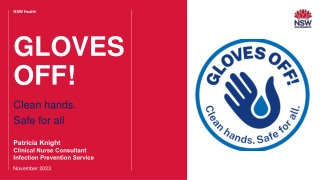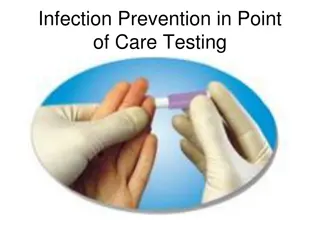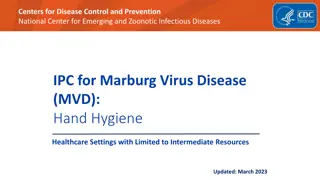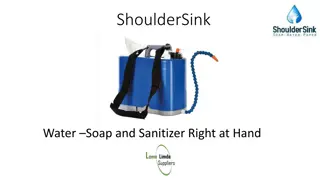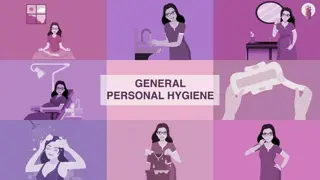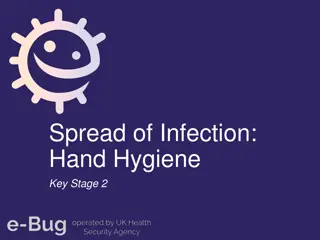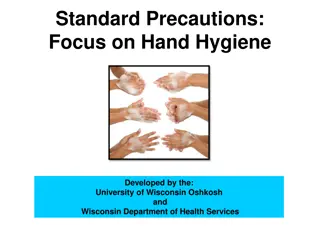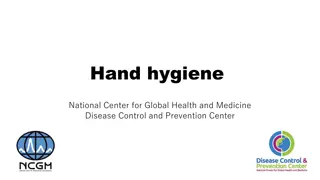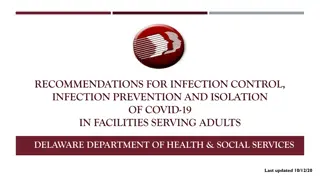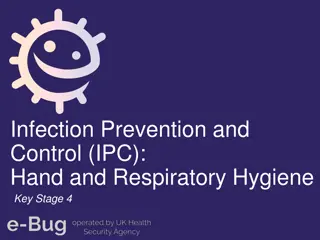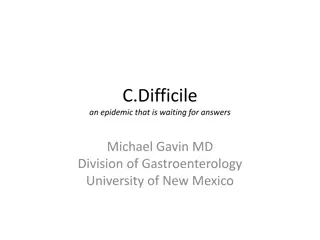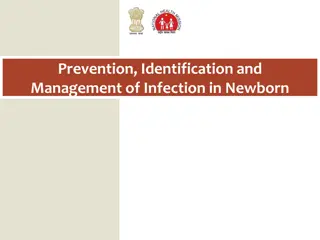Importance of Hand Hygiene in Infection Prevention
Hand hygiene is a crucial measure to prevent healthcare-associated infections (HAIs). This includes strategies to enhance compliance, comparison of available products, and adherence to current recommendations. The history of hand hygiene, risk factors for contamination, and the impact on infection transmission are discussed. Emphasizing the significance of maintaining proper hand hygiene practices is essential for healthcare professionals to mitigate the spread of infections effectively.
Uploaded on Sep 10, 2024 | 0 Views
Download Presentation

Please find below an Image/Link to download the presentation.
The content on the website is provided AS IS for your information and personal use only. It may not be sold, licensed, or shared on other websites without obtaining consent from the author.If you encounter any issues during the download, it is possible that the publisher has removed the file from their server.
You are allowed to download the files provided on this website for personal or commercial use, subject to the condition that they are used lawfully. All files are the property of their respective owners.
The content on the website is provided AS IS for your information and personal use only. It may not be sold, licensed, or shared on other websites without obtaining consent from the author.
E N D
Presentation Transcript
Learning objectives December 1, 2013 1. Describe the relevance of hand hygiene for infection prevention 2. Discuss strategies to improve hand hygiene compliance 3. Compare products available for hand hygiene 4. Explain current recommendations on hand hygiene practice 2
Time involved December 1, 2013 50 minutes 3
Key points December 1, 2013 Most effective single measure to prevent HAI Compliance often suboptimal, influenced by many factors Can be performed with soap and water or ABHR WHO recommends ABHR for routine HH HH promotion impacts practices and HAI Strategies: hand rubs, water, soap, towels, education, monitoring, reminders and promotion of safety climate 4
Background A measure of personal hygiene for centuries Semmelweis and Wendell Holmes established infection transmission by hands (1800) First international guidelines in 2009 Contaminated hands are the commonest route of transmission of HAIs Hand hygiene is the most effective measure to prevent HAIs December 1, 2013 5
Maternal Mortality: Lying-in Womens Hospital, Vienna 1841-1850 December 1, 2013 6
Skin flora December 1, 2013 Resident flora less likely to be associated with HAI Transient flora can cause HAIs Some activities lead to heavier hand contamination due to contact with patients or environment 7
Risk factors of hand contamination December 1, 2013 Contact with body fluids Diseased fingernails Dermatitis or skin lesions Subungual areas Skin underneath rings Artificial nails 8
Hand contamination December 1, 2013 HCWs can contaminate their hands or gloves with many pathogens Staphylococcus aureus, Enterococci, Clostridium difficile, Gram-negative bacilli, and some viruses By touching patients, body fluids or environment 9
Compliance among HCW -1 Many determinants lack of time, equipment/supplies, behavioural factors HH compliance < 40% without intervention Compliance varies by: work intensity type of ward professional category time of day/week December 1, 2013 10
Compliance among HCW -2 Lower compliance: high care intensity (e.g., ICU) among physicians before touching a patient Better compliance: after exposure to body fluids after glove use after contact with the patient or environment December 1, 2013 11
Hand Hygiene Products December 1, 2013 Alcohol-based formulation or soap and water Plain soap has minimal antimicrobial activity but mechanical friction removes many transient microorganisms 12
Antimicrobials Products December 1, 2013 Alcohol Chlorhexidine Chloroxylenol Hexachlorophene Iodine Iodophor Quaternary ammonium Triclosan 13
Antimicrobials in HH All effective against Gram-positive and Gram- negative Maximal efficacy - alcohol and iodophor Alcohol is effective against mycobacteria, fungi and viruses ethanol has greater activity against viruses than isopropanol Iodophor and chlorhexidine have some activity against viruses None has activity against spores December 1, 2013 14
Alcohol hand-rub -1 December 1, 2013 According WHO preferred method Broadest antimicrobial spectrum Short time (20-30 sec) Better skin tolerance Available at the point of care 15
Alcohol hand-rub -2 December 1, 2013 Efficacy depends on Concentration and quality Amount used Time spent Coverage of the hands surfaces Technique 16
Time of efficacy December 1, 2013 17 The Lancet Infectious Diseases, vol 1, Pittet D, Boyce
Points to consider in product selection December 1, 2013 Antimicrobial efficacy Good tolerance and minimal reactions Minimum drying time Aesthetic preferences of HCWs/patients Availability, convenience, and functioning of dispensers 18
Placement Issues December 1, 2013 21
When to Perform Hand Hygiene My five moments (WHO) A unified vision to minimise individual variation 1. before touching a patient 2. before clean/aseptic procedures 3. after body fluid exposure/risk 4. after touching a patient 5. after touching patient surroundings December 1, 2013 22
Glove use - 1 December 1, 2013 Prevent contamination of HCWs hands, reduce transmission of pathogens, and help control outbreaks Does not prevent HAI unless accompanied by other measures, including HH Must be used according indications Do not use the same gloves for several hours 24
Glove use - 2 December 1, 2013 Association between inappropriate use and low compliance with HH Glove use does not replace HH HH must be performed before donning gloves, as well as immediately after glove removal Gloves must be removed to perform HH 25
Improvement Strategies -1 December 1, 2013 1. System change (necessary infrastructure) access to water, soap, and disposable towels provision of alcohol-based hand rub at the point of care 2. Training/education on microbial transmission through hands and HH 3. Evaluation and feedback direct observation electronic monitoring alcohol-based hand rub consumption 26
Improvement strategies -2 December 1, 2013 4. Reminders in the workplace 5. Institutional safety climate active participation at institutional and individual levels awareness of capacity to change and improve partnership with patients and patient organisations 27
Applicable Guidelines December 1, 2013 Multimodal Hand Hygiene Improvement Strategy and Implementation Toolkit (WHO) Pilot tested in settings with different levels of resources significant improvement of practices, HCWs perception of HAI and its prevention substantial improvement in the facilities and equipment including low-cost provision of alcohol based hand rubs through local production 28
Current recommendations World Health Organization 29
Indications for HH -1 December 1, 2013 Soap and water when visibly dirty or visibly soiled (IB) after using the toilet (II) exposure to potential spore-forming pathogens including outbreaks of C. difficile (IB) Alcohol-based hand rub in all other situations (IA) Soap and alcohol-based hand rub should not be used concomitantly (II) 30
Indications for HH -2 Perform hand hygiene: before and after touching the patient (IB) before handling an invasive device regardless gloves (IB) after contact with body fluids, mucous membranes, nonintact skin, or wound dressings (IA) if moving from a contaminated body site to another body site of the same patient (IB) after contact with inanimate surfaces in the immediate vicinity of the patient (IB) after removing sterile (II) or non-sterile gloves (IB) Before handling medication or preparing food (IB) December 1, 2013 31
Hand hygiene technique Cover all surfaces of the hands with alcohol-based hand rub. Rub hands until dry (IB) When use soap and water, cover all surfaces. Dry with a single-use towel. Clean, running water whenever possible. Avoid hot water, as exposure may increase the risk dermatitis (IB) Use a towel to turn off tap/faucet (IB) Dry hands using a method that does not recontaminate hands. Make sure towels are single use (IB) All forms of soap are acceptable. When bar soap is used, small bars that facilitate drainage should be used to allow the bars to dry (II) December 1, 2013 32
Surgical hand preparation -1 Remove rings, wrist-watch, and bracelets (II) Artificial nails are prohibited (IB) Sinks should be designed to reduce splashes (II) If hands are visibly soiled, wash with soap before (II) Remove debris from underneath fingernails (II) Brushes are not recommended (IB) Use antimicrobial soap or alcohol-based hand rub, preferably with sustained activity (IB) If quality of water is not assured use an alcohol-based hand rub before sterile gloves (II). When use antimicrobial soap, scrub hands and forearms 2 5 minutes. Long scrub times are not necessary (IB) December 1, 2013 33
Surgical hand preparation -2 December 1, 2013 When using an alcohol-based surgical hand rub follow manufacturer s instructions for application times apply the product to dry hands only (IB) not combine surgical hand scrub and surgical hand rub with alcohol-based products sequentially (II) use sufficient product to keep hands and forearms wet throughout the procedure (IB) After application, allow hands and forearms to dry thoroughly before donning sterile gloves (IB) 34
Selection and handling of hand hygiene agents -1 Products with low irritancy (IB) With input of HCW acceptance (skin tolerance, feel, and fragrance) (IB) Knowledge about interaction between HH, skin care products and types of gloves (II) Information about the risk of product (IB) Dispensers must ensure accessibility at the point of care (IB) function (II) system for alcohol-based hand rubs approved for flammable materials (IC) December 1, 2013 35
Selection and handling of hand hygiene agents -2 December 1, 2013 Evaluate information about effect that lotions, creams or alcohol-based hand rubs may have on the effects of antimicrobial soaps (IB) Cost comparisons only for products that meet requirements (II) Do not add soap (IA) or alcohol-based formulations (II) to a partially empty soap dispenser 36
Skin care December 1, 2013 Education about how to reduce risk of dermatitis and skin damage (IB) Alternative products for HCWs with allergies or adverse reactions to standard products (II) Hand lotions or creams (IA) When alcohol-based hand rub is available the use of antimicrobial soap is not recommended (II) Soap and alcohol-based hand rub should not be used concomitantly (II) 37
Use of gloves Does not replace HH (IB) Wear when anticipated contact with blood or other potentially infectious materials, (IC) Remove gloves after caring. Not the same pair for the care of more than one patient (IB) Change or remove gloves if moving from a contaminated body site to another within the same patient or the environment (II) The reuse of gloves is not recommended (IB) In the case of glove reuse, implement the safest reprocessing method (II) December 1, 2013 38
Other aspects of hand hygiene December 1, 2013 No artificial fingernails or extenders when having direct contact with patients (IA) Natural nails short tips less than 0.5 cm long or approximately inch (II) 39
Educational and motivational programs for healthcare workers December 1, 2013 Focus on factors that influence behavior not only on products. Multimodal strategy (education/support) (IA) Educate about hand contamination and advantages and disadvantages of methods for HH (II) Monitor adherence to HH and feedback (IA) Partnerships between patients, families and HCWs (II) 40
Governmental and institutional responsibilities for health care administrators December 1, 2013 Safe, continuous water supply and access in the facilities (IB) Alcohol-based hand rub at the point of care (IA) Improved hand hygiene adherence as a priority (IB) Time for infection control training (II) Multidisciplinary, multifaceted and multimodal program to improve adherence of HH (IB) Water supply separated from drainage and sewage system to monitor and management (IB) Leadership and support for HH and IC (II) Alcohol-based hand rub production and storage according to guidelines and legal requirements (II) 41
For National Governments December 1, 2013 HH adherence a national priority. Consider funded programm ensuring sustainability (II) Support strengthening of infection control in healthcare settings (II) Promotion of HH in the community (II) Encourage healthcare settings to use HH as a quality indicator (II) 42
Summary December 1, 2013 Hands play a crucial role in transmission of microorganisms HH is the single most effective measure to prevent HAI HH practice usually suboptimal Improvement achieved by multimodal strategies Alcohol-based hand rubbing is the gold standard for HH Identification of the right moments is essential 43
References Boyce JM, Pittet D. Guideline for hand hygiene in health- care settings. Morb Mortal Wkly Rep Recomm 2002 25; 51:1-45. http://www.cdc.gov/mmwr/PDF/rr/rr5116.pdf World Health Organization. Alcohol-based handrub planning and costing tool 2010. Available from: http://www.who.int/gpsc/5may/tools/system_change/en /index.html Allegranzi B, et al. Successful implementation of the World Health Organization hand hygiene improvement strategy in a referral hospital in Mali, Africa. Infect Control Hosp Epidemiol 2010; 31:133-41. December 1, 2013 44
References World Health Organization. Hand hygiene technical reference manual. 2010. Available from: http://www.who.int/gpsc/5may/tools/training_ education/en/index.html Sax H, et al. My five moments for hand hygiene : a user- centred design approach to understand, train, monitor and report hand hygiene. J Hosp Infect 2007; 67:9-21. Allegranzi B, Pitt et D. Role of hand hygiene in healthcare-associated infection prevention. J Hosp Infect 2009; 73:305-15. December 1, 2013 45
Key web sites Centers for Disease Control and Prevention: Hand Hygiene in Healthcare Settings. http://www.cdc.gov/HandHygiene/index.html Germs. Wash your hands of them: http://www.washyourhandsofthem.com/home.aspx Hand Hygiene Resource Centre: http://www.handhygiene.org/ Institute for Healthcare Improvement (IHI): http://www.ihi.org/knowledge/Pages/Tools/HowtoGuide ImprovingHandHygiene.aspx National Resource for Infection Control (NRIC): http://www.nric.org.uk/IntegratedCRD.nsf/CleanYourHan ds2010?OpenForm December 1, 2013 46
Quiz December 1, 2013 1. 2. Gloves use can replace hand hygiene in routine work? T/F In a multimodal strategy to improve hand hygiene, which of the following should be included: a) Structural elements b) Health care education c) Reminders d) All of the above Alcohol based hand rub solutions are the gold standard for HH mainly because they: a) Are cheaper b) Reduce time of HH with similar efficacy c) Can be prepared in the same hospital d) Are recommended by WHO 3. 47
International Federation of Infection Control IFIC s mission is to facilitate international networking in order to improve the prevention and control of healthcare associated infections worldwide. It is an umbrella organisation of societies and associations of healthcare professionals in infection control and related fields across the globe . The goal of IFIC is to minimise the risk of infection within healthcare settings through development of a network of infection control organisations for communication, consensus building, education and sharing expertise. For more information go to http://theific.org/ December 1, 2013 48


